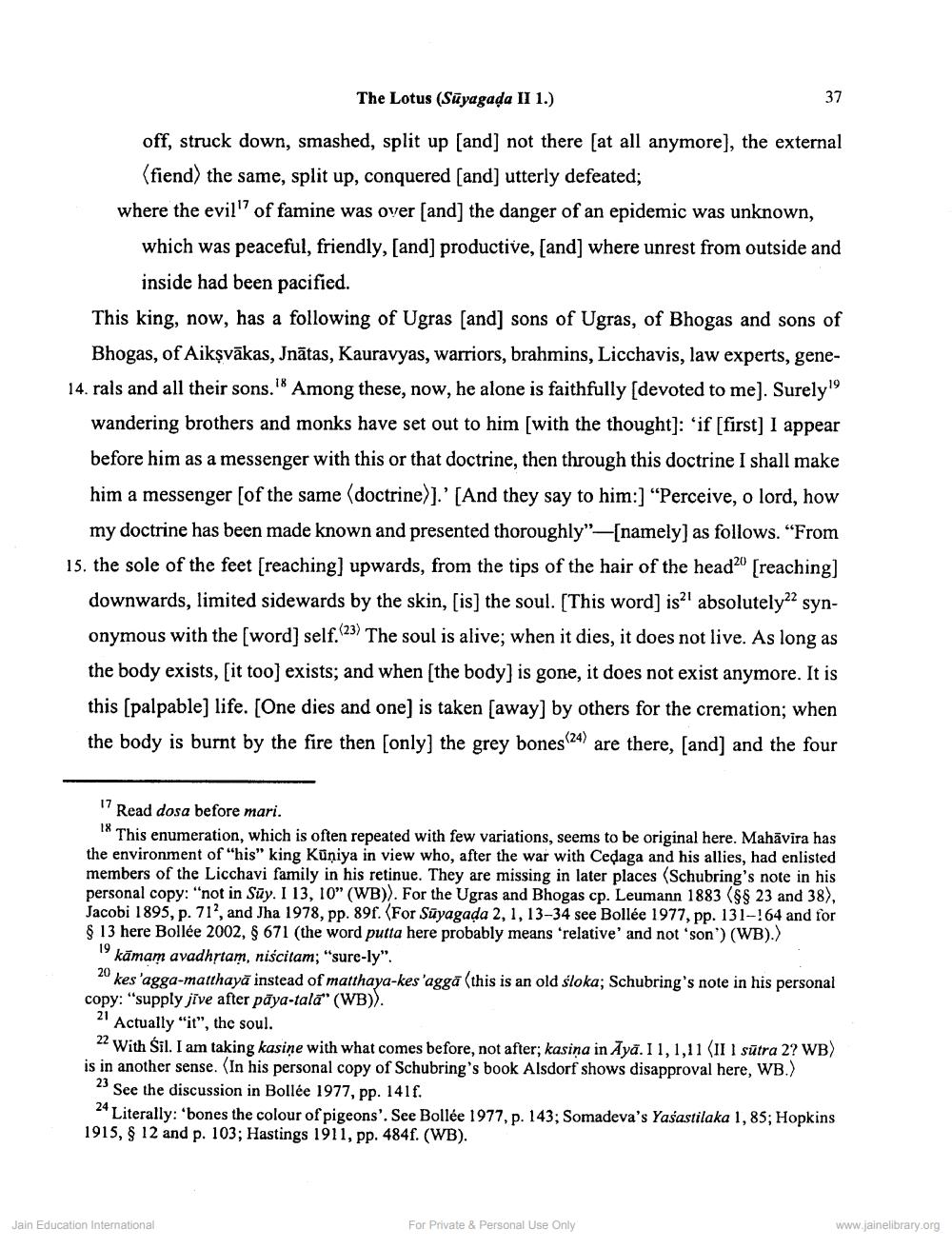________________
The Lotus (Suyagaḍa II 1.)
off, struck down, smashed, split up [and] not there [at all anymore], the external (fiend) the same, split up, conquered [and] utterly defeated;
where the evil" of famine was over [and] the danger of an epidemic was unknown,
which was peaceful, friendly, [and] productive, [and] where unrest from outside and inside had been pacified.
This king, now, has a following of Ugras [and] sons of Ugras, of Bhogas and sons of Bhogas, of Aiksväkas, Jnätas, Kauravyas, warriors, brahmins, Licchavis, law experts, gene14. rals and all their sons." Among these, now, he alone is faithfully [devoted to me]. Surely19 wandering brothers and monks have set out to him [with the thought]: 'if [first] I appear before him as a messenger with this or that doctrine, then through this doctrine I shall make him a messenger [of the same (doctrine)]."' [And they say to him:] "Perceive, o lord, how my doctrine has been made known and presented thoroughly"-[namely] as follows. "From 15. the sole of the feet [reaching] upwards, from the tips of the hair of the head20 [reaching] downwards, limited sidewards by the skin, [is] the soul. [This word] is absolutely synonymous with the [word] self. The soul is alive; when it dies, it does not live. As long as the body exists, [it too] exists; and when [the body] is gone, it does not exist anymore. It is this [palpable] life. [One dies and one] is taken [away] by others for the cremation; when the body is burnt by the fire then [only] the grey bones(24) are there, [and] and the four
(23)
37
17
Read dosa before mari.
18
This enumeration, which is often repeated with few variations, seems to be original here. Mahavira has the environment of "his" king Küniya in view who, after the war with Cedaga and his allies, had enlisted members of the Licchavi family in his retinue. They are missing in later places (Schubring's note in his personal copy: "not in Suy. I 13, 10" (WB)). For the Ugras and Bhogas cp. Leumann 1883 (§§ 23 and 38), Jacobi 1895, p. 712, and Jha 1978, pp. 89f. (For Suyagada 2, 1, 13-34 see Bollée 1977, pp. 131-164 and for § 13 here Bollée 2002, § 671 (the word putta here probably means 'relative' and not 'son') (WB).) 19 kāmam avadhṛtam, niscitam; "sure-ly".
20 kes 'agga-matthaya instead of matthaya-kes 'agga (this is an old sloka; Schubring's note in his personal copy: "supply jive after paya-tala" (WB)).
21 Actually "it", the soul.
22 With Sil. I am taking kasine with what comes before, not after; kasina in Aya. I 1, 1,11 (II 1 sūtra 2? WB) is in another sense. (In his personal copy of Schubring's book Alsdorf shows disapproval here, WB.)
23 See the discussion in Bollée 1977, pp. 141f.
24 Literally: 'bones the colour of pigeons'. See Bollée 1977, p. 143; Somadeva's Yasastilaka 1, 85; Hopkins 1915, § 12 and p. 103; Hastings 1911, pp. 484f. (WB).
Jain Education International
For Private & Personal Use Only
www.jainelibrary.org




